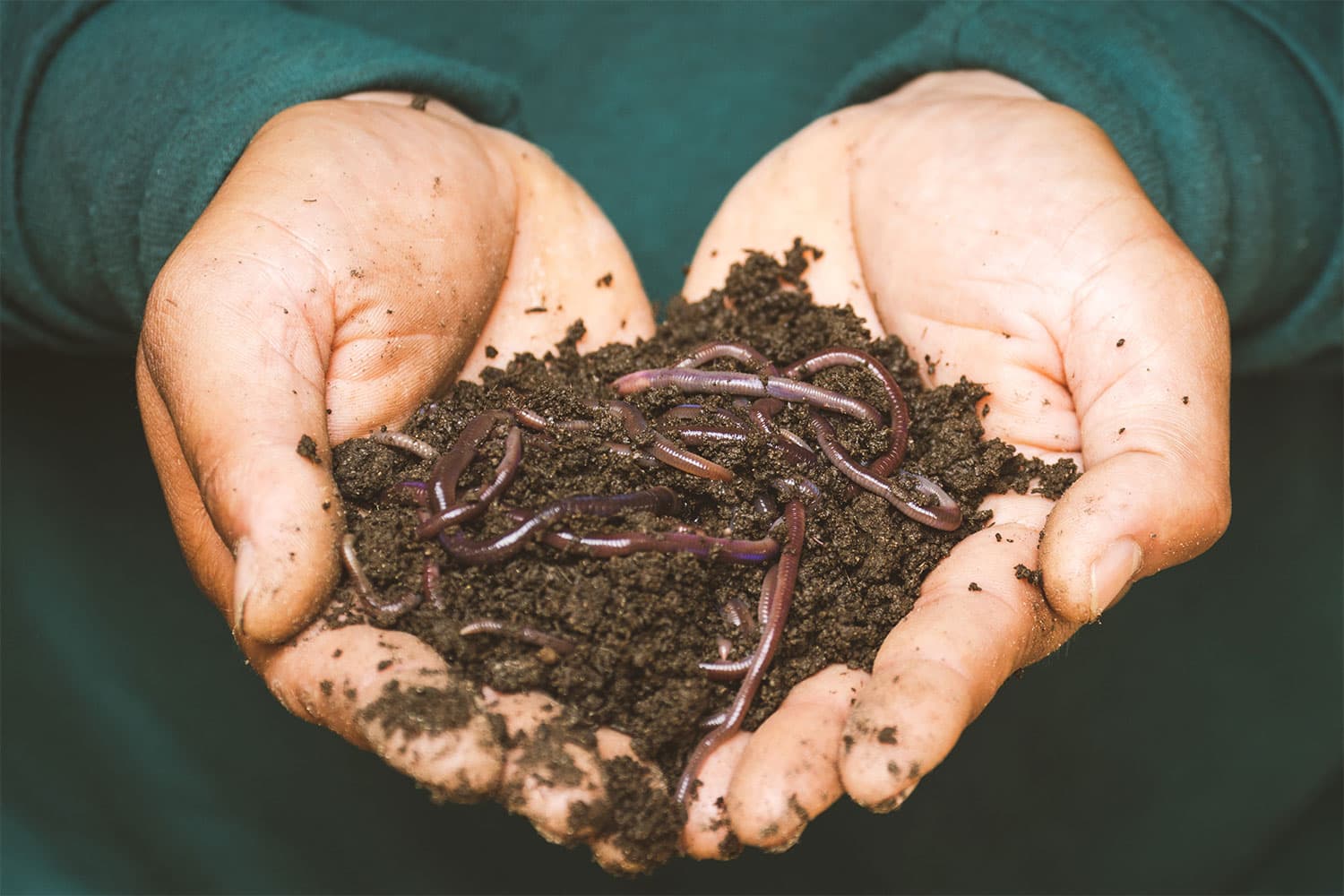The Gus List: Apartment Composters
We’ve found 6 compact composting options for greener urban living.
Personally, I’ve always wanted to compost. However, the combination of living abroad for many years, moving around a lot, and living in small apartments made it hard to find a workable solution for me.
And I’m not the only one. For people living in small apartments, composting is definitely not straightforward. And in some cities it’s becoming harder instead of easier; the Covid-19 pandemic cancelled New York City’s 7-year-old curbside composting program, and it’s not expected back until October of this year.
Luckily, there are ways to overcome barriers to urban composting. When I expressed my desire to compost, my friend Jessica Panicola was able to help, sharing information about apartment composting systems including the one she designed herself, called Compottery.
Composting terms you need to know
- Composting: The breakdown of decaying organic matter into a nutrient-rich medium for growing plants.
- Soil: Compost can be one aspect of soil, which can also include clay, sand, rocks, and microorganisms.
- Vermicomposting: Composting with the aid of worms.
- Vermicast/castings: Essentially worm poop.
- Tray composting method/vertical migration system: This process involves using trays or similar objects to store the composting materials as the worms do their work. The newest food scraps go in the tray on the top, and composted soil can be taken out from the tray on the bottom. Holes in the tray bottoms allow the worms to move through the system, composting as they go. After castings are harvested from the bottom tray, it can be rotated to the top and filled with new scraps.
- Bokashi method: A process of converting food waste into compost through fermentation (as opposed to decomposition) by a combination of microorganisms. In this method, food scraps are layered with “Bokashi bran” — a mixture of wheat bran, microorganisms that thrive in anaerobic environments, and molasses intended to spur rapid microorganism reproduction — in an airtight bin. Bokashi composting generally produces less odor than decomposition.
- Green compost: Materials rich with protein and nitrogen, i.e. food scraps, coffee grounds, tea bags.
- Brown Compost: Carbon or carbohydrate-rich materials, i.e. leaves, twigs, paper.
There are urban composters to suit all kinds of apartment-dwellers. Here are six options that match a range of lifestyles.
Best for beginners: Compottery
Compottery is the solution for urbanites with little-to-no composting experience who have limited time and space. The system uses modular, stackable ceramic pots for tray vermicomposting, which double as planters where you can grow your own microgreens. Like me, Panicola found it difficult to compost in her home in Union City, NJ. But she also couldn’t stand throwing her scraps in the trash.

After some trial and error, Panicola found a worm bin that worked for her. “I was able to compost most of my food scraps and therefore divert it from the landfill,” she said. “The designer in me began to see opportunities to make a decentralized method for other urban dwellers to compost, and also reap the benefits of composting from limited, indoor space.”
Compottery is a functional composter that will look great on any counter, desk, or in a corner, blending in beautifully with other decor.
Price: US$130+
Best for modern design: Living Composter
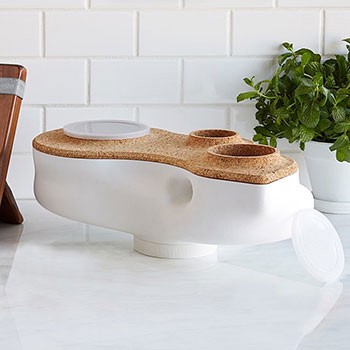
The challenge of creating apartment composters is designing something that’s functional, odorless, and looks more interesting than traditional worm farms. Living Composter — sold by Uncommon Goods — meets all these challenges. It’s a classy-looking composter made of cork and recycled plastic, which fits in the coziest of apartments. The worms inside can process over a kilogram of food scraps a week, which is enough for you and your roommates, kids, spouse…whatever. When the composting process is complete, it’s easy to remove the compost and give it to your house plants, which will surely look great next to this baby.
Price: US$199
Best for minimalist apartments: The Worm Studio

Akil Mesiwala has been vermicomposting kitchen scraps in his apartment for the last five years. He wanted more people to know about the process of transforming food waste into healthy, living soil, so he quit his corporate job to found a composting company called The Box of Life. Mesiwala designed the Worm Studio, a vertical migration vermiculture system with a minimalist aesthetic that makes composting intuitive and hassle-free to enable mass adoption.
A few things set the Canadian-made Worm Studio apart from other composters: the boxes are made of rot-resistant cedar, and their rope handles make the bins more accessible for use by all ages because they’re easy to lift and move when harvesting the castings. Mesiwala says his company prioritizes zero-waste manufacturing, sustainable sourcing, ethical practices, and customer support. “My goal is to build a life-long habit of composting,” he says.
Price: about US$165 (currently only ships in Canada)
Best for dedicated composters: Worm Farm Composter
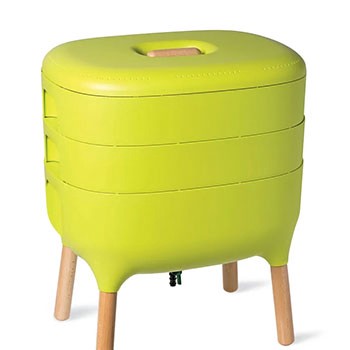
If the list entries so far seem too dainty for your composting needs, Gardeners Supply Company’s Worm Farm Composter could be right for your not-so-small apartment situation. It uses the tray system, and can comfortably process food scraps from a family of four (about 1.5 kg/week). Unlike the other tray systems in this list, it produces nutrient rich “compost tea” that needs to be drained periodically, but can be used to fertilize plants.
Price: US$179
Best for convenience: Urban Composter USA
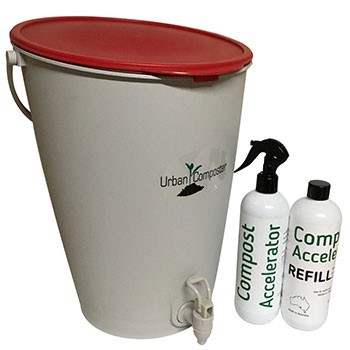
Urban Composter USA uses a spin on the Bokashi method. Creator Luke Gregory found Bokashi bran hard to manage and likely to attract bugs and rodents. According to the Urban Composter website, Gregory believes that “People won’t compost if it’s difficult,” but they will if it’s convenient.
So, he researched a different anaerobic composting method that didn’t require Bokashi bran, but instead uses a citrus-based spray to start the fermentation process. All you have to do is throw in your scraps, spray them, and drain the “tea” every few days. Once the bucket is full, it needs to ferment for a week or two before the resulting pulp is ready to be dumped out. However, it then needs another 4–8 weeks buried in soil before you can plant into it, so this option is best if you have an outdoor space where you can keep a large planter.
Price: US$59.95 + cost of spray and refills
Best for outdoor spaces: Envirocycle Mini
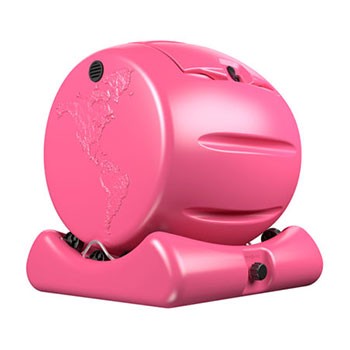
Let’s be honest: for some homes in some cities, even an apartment composter might take up too much space. This is where the US-made Envirocycle Mini comes in. Marketed as “the cutest composter in the world,” it does best on a balcony or in a small garden. Load the composter with green and brown compost, and rotate the drum three times every three days. You’ll have mature compost every four to eight weeks. You can use worms to speed up the process, but it’s not required. The Envirocycle Mini can be shipped all over the world.
Price: US$189.99
When I moved back to the US, I knew I had no excuses left not to compost. Jessica gave me a Compottery set as a housewarming present, and composting has become second nature. My wormies have become like pets! Based on my experience, I believe even those whose apartments are “too small” or who “don’t have the time,” can find a compost set-up that will do the trick.
